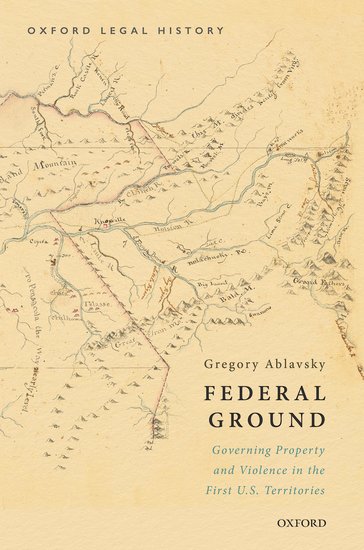Federal Ground
Governing Property and Violence In the First U.S. Territories

Federal Ground explores the legal and constitutional history of the first two federal territories, the Northwest and Southwest Territories. Federal territories were a constitutional innovation in which the federal government temporarily held complete control before the territories became eligible for admission as states. In both territories, the United States inherited a complex history of struggles over ownership and power among Native nations, European empires, and Anglo-American colonists. The book recounts how the federal government sought, and often failed, to resolve conflicts over property and violence that arose in the territories. Yet, as territorial residents looked to federal officials to adjudicate their conflicts, the federal government gained unexpected, though diffuse, authority in the territories as it distributed land and money. Despite the challenge, this power endured even after the Southwest Territory became the new state of Tennessee in 1796 and part of the Northwest Territory became the new state of Ohio in 1803. This history provided the foundation for both enduring federal authority and resentment, as recounted in the excerpt below from the book’s epilogue.
It took legislatures and courts nearly a century to unspool the tangle of title and authority created in Tennessee and Ohio in the 1780s and 90s. Yet the history of the first two territories obscured this long and difficult process: both appeared striking successes when measured against the aims of the territorial system and their citizens’ aspirations. Both had passed quickly from territory to state (the Southwest Territory’s six-year existence was the second-shortest territorial period in U.S. history, exceeded only by silver-mad Nevada during the Civil War). And in both, federal colonialism’s key work—defining, then confining and extinguishing, prior rights to ownership and sovereignty inherited from a long and complicated past—was well underway by the time of statehood.
Commentators then and now explained these territories’ apparent success in divergent ways. Some adopted the narrative of John Sevier [first governor of the new state of Tennessee], that territorial citizens, neglected by an indifferent federal government, pull themselves up by their own bootstraps. Others, taking the opposite tack, attributed the territories’ rapid transformation to a cruelly effective scheme of dispossession engineered and executed by the federal government, which moved peoples around the continent like so many chess pieces.

Both accounts overlook what was arguably the more accurate explanation: that the early territories fulfilled Anglo-Americans’ long-standing settler colonial aspirations due less to self-help or the unfolding of a careful federal plan than to territorial citizens’ skill at exploiting federal power for their own ends. This reality had important consequences for subsequent territories. In Illinois, Indiana, Alabama, and Mississippi the chief industry was the land office business, just as it had been in the Northwest and Southwest Territories. As a result, the chief demand of these territories’ citizens remained federal dispossession of Native peoples and other longtime residents. But in the upper Great Lakes, or in much of the trans-Mississippian West, territorial rule outpaced the demographic transformation that drove the booming trade in title. Residents there instead expanded on a different facet of the early territorial experience: federal money as a resource. They farmed the federal government itself, with the result that the federal government found itself managing rather than supplanting pluralism. The supposedly temporary federal role became increasingly permanent.
Yet the mistaken narratives about the earliest territories mattered. Assumptions about the first territories became the yardsticks against which subsequent territories were measured. Evaluating later territories against the myth of a rapid transition, Congress concluded that these newer territories were too diverse and pluralist to have earned the symbolic marker of statehood. Congress consequently extended their territorial infancy for decades—and, as the U.S. empire extended to insular possessions, abandoned the promise of statehood altogether. Former territories that did attain statehood immediately clamored for what they thought the earlier states had gotten; many of them are clamoring still. They, too, wanted pluralism erased, title to public lands secured, and Native sovereignty extinguished. To achieve these ends, they repurposed the constitutional language of state sovereignty and equal footing advanced decades and centuries earlier, although not always successfully.
And so, just as in the first territories, these states turned in anger at the institution they perceived as the most visible impediment to these goals—the federal government. Even more than the first territories had been, these “independent” states remained economically and politically dependent on federal authority. But this irony was less a paradox than one of the oldest patterns of U.S. governance, with the understudied Southwest Territory as a particularly strong harbinger of later history. The territory’s many successors have uncannily echoed its dual history as an effective exploiter of federal largesse and seedbed for anti-federal resentment. SL
